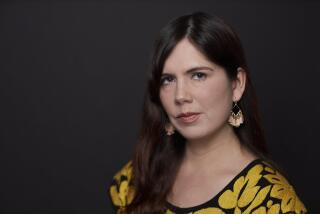‘Crossers’ by Philip Caputo
Crossers
A Novel
Philip Caputo
Alfred A. Knopf: 452 pp., $26.95
Rather than a Milagro Beanfield-style war over water rights, in Philip Caputo’s “Crossers” we have a veritable hot zone, with faceoffs between drug runners packing automatic pistols, illegal immigrants led (or abandoned) by their coyote guides, Mexican federal police, the U.S. Border Patrol and ranchers whose private property is, by default, a no-man’s land, skeined with paths not made by their cattle.
“This is the border. There’s a lot of dead people around here ain’t in cemeteries,” is how Sally, matriarch of one of the large ranches, puts it. Caputo uses this torn-from-the-headlines setting -- where Arizona abuts Mexico, in the San Rafael Valley -- to play New West and Old West stereotypes against each other. In the high-tech watch posts guarding entry to the U.S., we have “ ‘Star Wars’ joining hands with the Old West, two myths linked by the gringo faith in technology to overcome, the Winchester repeating rifle that cleared the plains of buffalo and Indians, ancestor to the electronic sensors and infrared cameras that kept the Mexicans out.”
And yet the “reconquistadores” are “slowly taking back with demographics what was stolen from us with the gun a century and a half ago,” asserts a character known as the Professor. He has aliases on both sides of the border and is a captain in the Mexican Federal Judicial Police but also a naturalized U.S. citizen, a former U.S. Drug Enforcement Administration operative and someone who draws a paycheck from Joaquin Carrasco, one of the novel’s Mexican drug kingpins. Asked if he is a double or triple agent, he replies, “I’m an agent of history.” (There’s crossing for you.)
There are other types of borders to be negotiated in life, of course, and one of these must be crossed by Gil Castle, a textbook East Coast Brahmin who moved west seeking respite from grief after his second wife (his first had left him for a woman) was killed at ground zero on Sept. 11. A graduate of Hotchkiss, Princeton and the Wharton School, Gil had a stellar career in the fourth-largest investment firm on the planet and had become a multimillionaire, star of its retail division and an executive. His one mistake, he believed, “had been to believe that his luck would last.”
After spending more than a year despondent among his dead wife’s belongings at their Connecticut house, and after renouncing suicide only at the last moment -- with the shotgun in his mouth, he looks “a bit like a Turk smoking a hookah” -- Gil decided to cut his Eastern ties. He gave away three-fourths of his fortune, piled his dog and few belongings into his Suburban and drove to the Arizona ranch owned by his cousin Blaine, Blaine’s wife, Monica, and his Aunt Sally. Castle considered himself “a refugee of the strange new war.”
Yet the type of war that Gil encounters in the West -- thematic links of terror are drawn in parallel with Gil’s family links -- is new only to him. As a Navajo tracker for the Border Patrol informs him, “this valley has been a drug corridor for twenty years.” Despite some of Caputo’s excellent observational riffs and moments of high irony, it should be noted that back stories as overcooked as the ones affixed to the Professor and Gil Castle accompany yet other characters in “Crossers” to the novel’s detriment. It’s as if Caputo had mounted them atop an emotional or situational cliché and slapped its haunches to see how far they could ride before being thrown.
Fortunately, the practice of substituting shorthand social descriptors for illumination from a character’s interior is not universal in “Crossers.” It is most noticeable in the modern-day characters who, after all, exist in a narco-terror thriller, albeit one with higher-level aspirations of evoking truths about bloodshed, grief and vengeance.
Present and past
Their lives play out alongside a historical story line involving the grandfather of Gil and Blaine, a legendary Old West lawman and killer named Ben Erskine. That story, and the writing that delivers it, are sensationally better than other parts of the novel, and one speaker within it narrates sections so strong that it could be Mark Twain, with his wings only slightly clipped.
Caputo frames much of Ben’s story as documentary material -- largely oral histories recorded for the Arizona Historical Society and taken from Ben’s brother Jeff, a cattleman and founder of the San Ignacio Ranch (on which much of the novel takes place); a compañero of Ben’s named T.J. Babcock, who fought alongside him in the Mexican revolution, smuggled guns across the border with him and rustled cattle without calling it such (“soldiers of fortune with no fortune, that was us,” says Babcock); a vaquero who worked for Ben and witnessed two of his killings, one of those a youth of 13 or 14, and admits “I was a little afraid of him”; and a journalism professor who, back in his reporting days, covered some of Ben’s famous exploits as a deputy sheriff, including a chase “right out of the Lone Ranger and every oater Hollywood ever turned out.”
We are also privy to the correspondence of Grace Erskine Castle -- Ben’s daughter and Gil’s mother -- which includes her terrifying, even retrospectively, account of Ben shooting an assailant outside their house during her childhood, after which the “mantle of the killer still clung to him . . . a kind of repulsive force that held us at a distance.” Looking back on his acquittal for second-degree murder many years after the fact (and for a different shooting), she states, “To my mind, he was guilty of an unbending fealty to his own archaic code.”
Living by codes
The drug kingpins, undercover agents and ranchers we meet in “Crossers” each have a code, no doubt seen as archaic by anyone on the outside. This is a novel filled with bloodshed, organized and disorganized, back and forth across a border that does not exist outside the mind. People are set afire, people are executed, people are turned over to others for execution.
The porousness of that moral line, the smattering of Spanish, the violence and the setting may recall Cormac McCarthy’s “Border Trilogy” for many readers, but there is a superficial resemblance at best. There are two significant female killers in “Crossers” -- one of them fought in the Mexican revolution and was quite religious; the other heads a drug cartel and claims that her vendetta, which relates to the Erskines, is all about “justice.” Ben Erskine was called “the last ember of the true Old West” at his funeral, but perhaps a little skepticism is in order on that count.
Winslow is a former literary and executive editor of the Nation.
More to Read
The biggest entertainment stories
Get our big stories about Hollywood, film, television, music, arts, culture and more right in your inbox as soon as they publish.
You may occasionally receive promotional content from the Los Angeles Times.






